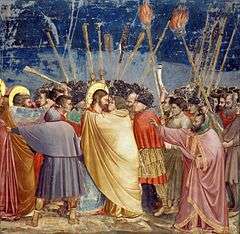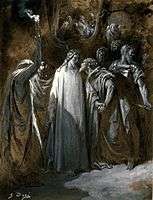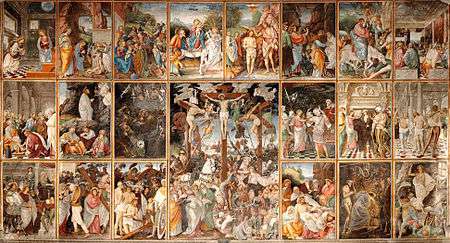Kiss of Judas

According to the Synoptic Gospels, Judas identified Jesus to the soldiers by means of a kiss. This is the kiss of Judas, also known (especially in art) as the Betrayal of Christ, which occurs in the Garden of Gethsemane after the Last Supper, and leads directly to the arrest of Jesus by the police force of the Sanhedrin.
More broadly, a Judas kiss may refer to "an act appearing to be an act of friendship, which is in fact harmful to the recipient."[1]
In the New Testament
Both Matthew (26:47–50) and Mark (14:43–45) use the Greek verb kataphilein, which means to kiss firmly, intensely, passionately, tenderly, or warmly. It is the same verb that Plutarch uses to describe a famous kiss that Alexander the Great gave Bagoas.[2] According to Matthew, Jesus responded by saying: "Friend, do what you are here to do." This has caused speculation that Jesus and Judas were actually in agreement with each other and that there was no real betrayal.[3]
In art
The scene is nearly always included, either as the Kiss itself, or the moment after, in the Arrest of Jesus, or the two combined (as above), in the cycles of the Life of Christ or Passion of Jesus in various media.
- Probably the best known is from Giotto's cycle in the Scrovegni Chapel in Padua.
- There is also a version called The Taking of Christ by Caravaggio or one of his disciples.[4]
- A sixth-century Byzantine Mosaic in Ravenna.
- A fresco by Barna da Siena.
- A sculpture representing the Kiss of Judas appears on the Passion façade of the Sagrada Família.
- The kiss of Judas in art
 Fresco by Fra Angelico, San Marco, Florence, 1437–1446
Fresco by Fra Angelico, San Marco, Florence, 1437–1446 Judas betraying Jesus with a kiss, in Grandes Heures of Anne of Brittany, between 1503 and 1508
Judas betraying Jesus with a kiss, in Grandes Heures of Anne of Brittany, between 1503 and 1508 Study for The Judas Kiss by Gustave Doré, 1865
Study for The Judas Kiss by Gustave Doré, 1865_-_James_Tissot.jpg) The Kiss of Judas by James Tissot, Brooklyn Museum, between 1886 and 1894
The Kiss of Judas by James Tissot, Brooklyn Museum, between 1886 and 1894 Der Judasskuss by Hans Breinlinger, 1920
Der Judasskuss by Hans Breinlinger, 1920
See also
| Events in the |
| Life of Jesus according to the Gospels |
|---|
 |
|
In rest of the NT |
|
Portals: |
- Bargain of Judas
- Chronology of Jesus
- Jesus predicts his betrayal
- Life of Jesus in the New Testament
- Kiss of death (mafia)
References
- ↑ "Judas kiss". TheFreeDictionary.com.
- ↑ Plutarch, Parallel Lives, Alexander, 67
- ↑ Pagels, Elaine at Karen L. King. "The Gospel of John suggests that Jesus himself was complicit in the betrayal, that moments before Judas went out, Jesus had told him, 'Do quickly what you are going to do' (John 13:27)". Reading Judas, The Gospel of Judas and the Shaping of Christianity, Penguin Books, New York, 2007, pages 3–4, ISBN 978-0-14-311316-4.
- ↑ For a discussion of the kiss of Judas with respect to Caravaggio's The Taking of Christ (now in the National Gallery of Ireland, Dublin), together with a summary of traditional ecclesiastical interpretation of that gesture, see Franco Mormando, "Just as your lips approach the lips of your brothers: Judas Iscariot and the Kiss of Betrayal" in Saints and Sinners: Caravaggio and the Baroque Image, ed. F. Mormando, Chestnut Hill, MA: The McMullen Museum of Art of Boston College, 1999, 179–90.
Further reading
![]() Media related to Kiss of Judas (close-up) at Wikimedia Commons
Media related to Kiss of Judas (close-up) at Wikimedia Commons
- Grubb, Nancy (1996). The Life of Christ. New York City: Abbeville Publishing Group. ISBN 0-7892-0144-5. OCLC 34412342.